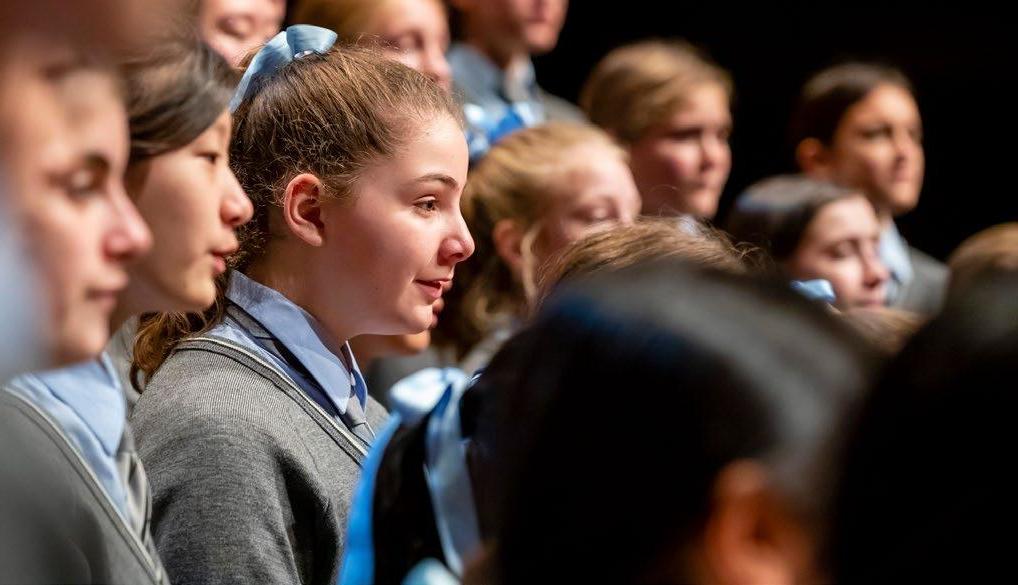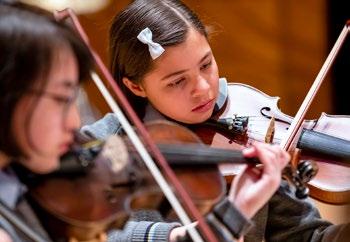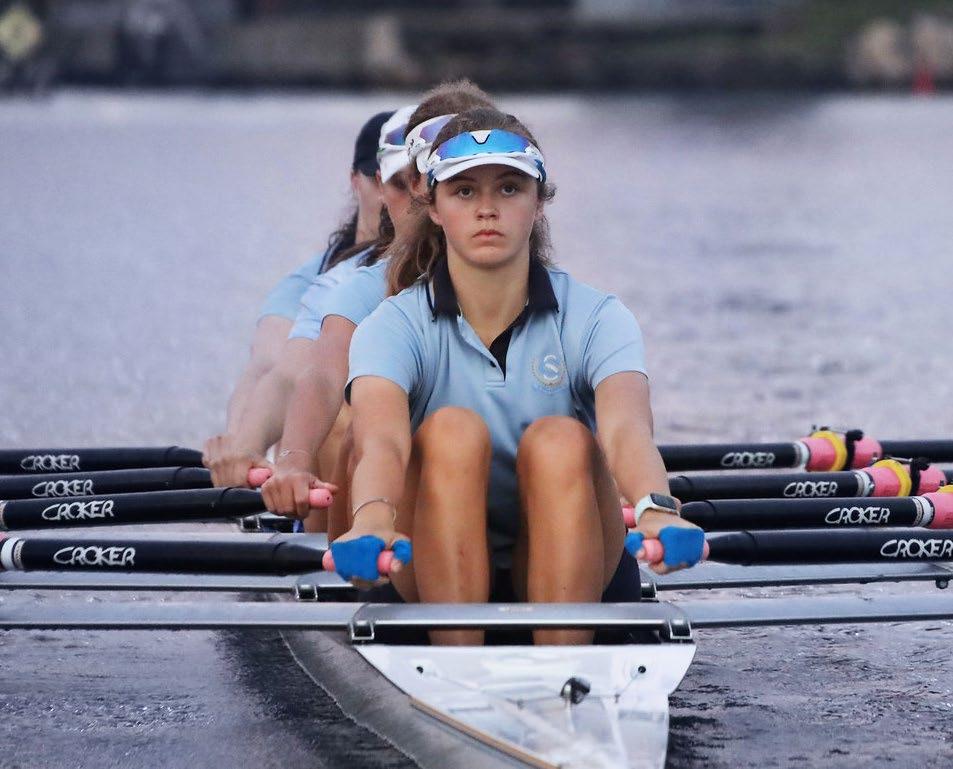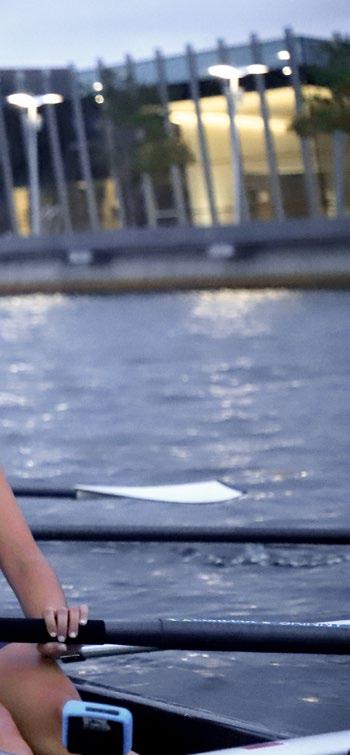
7 minute read
Our Senior School
Before music hits our ears it exists in the air as an intricate series of pressure waves. What is fascinating is the incredibly complex decoding that our brains perform in order to perceive this jumble as music. Simply being able to recognise an instrument from its tone (timbre) requires incredible computing power.
HARMONIC SERIES
How is it that most of us can instantly distinguish whether we are listening to a trombone or a violin even if they are playing simultaneously, or buried deep within a symphony orchestra? When any physical instrument (not a synthesizer) ‘plays a note’, it also generates a number of other notes. When a trombone plays an ‘A’ at 220 Hertz, it also produces the note ‘A’ (440Hz) an octave above, the ‘E’ (660Hz) above that, the ‘A’ (880Hz) above that, then C# (1.1kHz), E (1.32kHz), G (1.54kz), A again (1.76kHz), B, C, C#. This pattern continues ad Infinium but the frequencies get so close together that they no longer correlate notes on the piano. This is the harmonic series and was well known to Pythagoras in the 6th Century BCE. The harmonic series occurs in nature and contains within it a pentatonic scale (A, C#, D, E, G, A in the above example). Possibly, this is why most cultures share the pentatonic scale as the basis of their traditional melodies. All of our students in Year 8 will be familiar with the pentatonic scale as it forms the basis of our aural training in Years 7 and 8. The harmonic series is the reason the bugle can play the Last Past without any valves at all.
TROMBONE VS VIOLIN
When a trombone plays an ‘A’ and a violin plays an ‘A’ the same harmonic series is present in both. It is the relative volume of each one of these ‘overtones’ that is specific to the instrument.
When a Violin plays ‘A’ at 220Hz this is the loudest and is the ‘note name’ we assign to this sound. This is called the fundamental. The 2nd harmonic (1st overtone) an octave above (A 440Hz) is ½ as loud as the fundamental (A 220Hz). The 3rd harmonic ‘E’ (2nd overtone) is a 1/3 as loud, and the 4th (‘A’ 2 octaves above) is ¼ as loud. This forms a timbral ‘profile’ for violin that we have stored away somewhere.
It is different for the Trombone. The 3rd harmonic (E an octave and a 5th above) is the loudest. This is apparent when we tune the trombones in Senior Concert Band. The 2nd harmonic (‘F’ when we tune) is very prominent (reinforced by multiple instruments), however, it is the (softer) fundamental (Bb) that we think we hear. It seems that we have developed some form of built-in harmonic template that guides us to only hear the lowest frequency and identify that as the ‘note’.
It is only after I point out the 2nd harmonic, by (singing it) that students appreciate its presence in the room. Even then, not everyone can hear it. It’s one of those things that is impossible to communicate with words. Students are often unsure that they have heard the right sound but it is easy to tell from their faces when they discover it. Once you have heard it, it’s impossible to unhear. This ‘frequency template’ that we store for the trombone and can apply, no matter what note the trombone is playing. Even more amazingly, when listening to an orchestra, our brains can ‘recognise’ the trombone profile, from amongst all the other instruments that are playing. A trained musician can even transcribe the trombone melody into notation. This requires the incredible, parallel computing power of a brain. We currently do not have a computer powerful enough to emulate this skill.


MISSING FUNDAMENTAL i
This harmonic series generates some interesting anomalies and artefacts, two of which are described here.
Even though I may no longer be able to hear 27Hz in a hearing test, I can quite clearly perceive the lowest note on the piano which is A (27Hz). This is because hearing tests are conducted using pure sine waves but the low ‘A’ on the piano is rich in harmonics. The upper harmonics of this note, which I can still hear, generate a waveform that has the same period as the fundamental, so I still perceive this note, loud and clear. The landline telephone system can only carry frequencies as low as 300Hz but we can still hear a male voice as low as 100Hz because of the same phenomenon. Mp3 files and tiny speakers also make use of this.
HARMONIC SINGING
When we sing or speak we are constantly modulating the timbre (harmonic spectrum) of our voice. Sing the vowel sound ‘iiii’ (as in Yip) then ‘or’ as in (more) both on the same note. The first sound is rich in upper harmonics and sounds ‘bright’ and piercing. The ‘or’ sound is warm and dark, because its upper harmonics are suppressed. This is what happens when you turn down the tone knob on a stereo system. Students in Years 7-12 music are used to describing timbre in this way. With a knowledge of harmonics, we can do things with our voice that instruments cannot. By changing tongue position and mouth shape it is possible to isolate and amplify a single upper harmonic and suppress the others (harmonic singing) thus giving the impression that you are singing two notes simultaneously. ii iii iv
This article is simply about the harmonic series of a single note. Really interesting and complex things start to happen when you combine more than one note but that is for another time.
Mr Tim Collins Head of Music
References:
i. https://www.youtube.com/watch?v=0amvhGzeCnQ – 11. The missing fundamental ii. https://www.youtube.com/watch?v=iyhXP_wfnz4 –
David Hykes & the Harmonic Choir ii. https://www.youtube.com/watch?v=vC9Qh709gas – polyphonic overtone singing – Anna-Maria Hefele iv. https://www.youtube.com/watch?v=xa0v0pT9flo –
Live Performance Bukhchuluun Ganburged TEDxSydney


Rowing offers invaluable lessons about teamwork. It requires one to put the best interest of the crew above themselves. The role of the crew is to ensure that everyone can perform at their best, and together individuals must work to be the best version of themselves and enable those around them. Crews learn to work together through being patient, empathetic, hardworking and driven. The teamwork required in rowing teaches students to have a mutual respect for one another, to communicate and to be disciplined when working towards a common goal.

Although many people cannot understand why anyone would wake up very early in the morning to row a boat backwards down a river, rowing is a sport that teaches students so much about themselves and is exceptionally rewarding. Rowing not only develops strength, power and aerobic capacity but also instils resilience, determination and the value of hard work. It is a sport in which effort is rewarded, and the more you put in, the more you will get out of it.
Since the beginning of Term 3 the students involved in the St Catherine’s Rowing program have been working exceptionally hard, trying to be the best they can. The culmination of the Rowing season is the Head of School Girls Regatta 2020, which was established over 30 years ago. The Regatta includes over 2000 competitors from 50 different schools and is the biggest single sex regatta held in the Southern Hemisphere. The St Catherine’s crews were well positioned in the 2020 Head of Schoolgirls Regatta with 12 out of our 15 crew boats winning their heats on Friday. The competition was to be held over 13-15 March 2020, though it was unfortunately cancelled on the Friday afternoon, accepting the advice of the Chief Medical Officer of Australia regarding the Coronavirus. As the Head of School Girls Regatta is the final event of the Rowing season, the girls were naturally disappointed but handled the situation with grace. They had dinner in Geelong before returning to Melbourne, allowing them time to celebrate and reflect with their coaches on what they had achieved this season.
For the St Catherine’s Rowing Squad, this season has been one to remember. In the face of many challenges and hurdles, as a group the girls have demonstrated pride and professionalism, resilience, commitment, and teamwork, both on and off the water. The St Catherine’s Rowers and Coxes can be proud of what they have achieved this season. We look forward to coming back next season stronger, fitter and faster than ever before.










